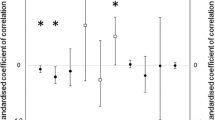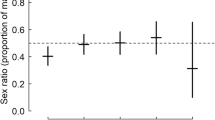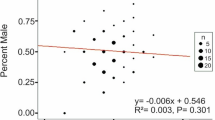Abstract
Understanding the causes and consequences of biases in the sex ratio at birth and of adults in species of mammals that have unusual life histories may help us know whether sex ratios are adaptive responses to ecological and evolutionary forces and may be important in conserving endangered species. For example, have sex ratio biases at birth and in adults in species of mammals evolved as an adaptive response to environmental unpredictability? We investigated the sex ratio of populations of hairy-nosed wombats, Lasiorhinus latifrons, and the endangered Lasiorhinus krefftii. The social structure of Lasiorhinus includes male philopatry and female dispersal, which are unusual traits among mammals. Reproduction in these wombats is often curtailed by unpredictable droughts, and so wombats may be a suitable target group for understanding the causes and consequences of biases in mammalian sex ratios. The sex ratio in populations of adult L. latifrons reported in the scientific literature varied widely, but the mean percentage of females in the 10 studies examined was 54.9 with a 95% confidence interval of 50.3 to 59.5. In the population of L. latifrons that we monitored for nearly twenty years beginning in 1994, the percentage of adult females varied between 66 and 37% in a manner that suggested homeostasis. The growth of the population of critically endangered L. krefftii from 52 males and 29 females in 2000 to 79 males and 91 females in 2016 suggested that more females than males were born. The sex ratio of pouch young of L. latifrons was biased towards females at times. The mean percentage of female pouch young in 19 breeding seasons was 56.4 (95% confidence interval of 50.4–62.4). Variation in the sex ratio of pouch young was examined regarding theories of sex allocation. When the percentage of adult females in the population was lower (37–50%) and had been declining, L. latifrons mothers had more female than male pouch young, but the sex ratio of pouch young was about equal when the percentage of adult females was higher (53–66%). This pattern is partly consistent with Fisher’s principle, which is also known as the homeostatic hypothesis (HH). When the percentage of adult females was lower, the mothers of female pouch young were in better condition than the mothers of male pouch young, which is consistent with a reversed Trivers–Willard (TW) effect in part. The biases in the sex ratio of adult and pouch young wombats may be adaptive responses to their life history and to demographic and environmental cues.
Significance statement
Wombats are unusual among mammals in that males are philopatric and females disperse. Hairy-nosed wombats (two species within the genus Lasiorhinus) exist tenuously in semi-arid environments because of infrequent reproduction, habitat degradation, and drought. L. krefftii is critically endangered. This study suggests that following severe droughts, a female bias in the sex ratio of pouch young and of adults may result in populations increasing more rapidly than if the sex ratio was equal. Agencies charged with managing and conserving wombats could make use of this knowledge by undertaking more comprehensive demographic monitoring of populations to evaluate their risk of extinction; a persistent male bias in adults may be a signal of an increased risk of extinction. The unpredictability of rainfall and drought across their distribution has resulted in variation in abundance and in genetic, ecological, and social parameters associated with wombat colonies, making these species valuable for exploring the causes and consequences of biases in mammalian sex ratios.


Similar content being viewed by others
Availability of data
The datasets related to L. latifrons used in this study are available from the corresponding author on reasonable request. The L. krefftii datasets used in this study are available from the Director, Wildlife and Threatened Species Operations, Queensland Department of Environment and Science on reasonable request.
References
Austad SN, Sunquist ME (1986) Sex-ratio manipulation in the common opossum. Nature 324:58–60
Banks SC, Skerratt LF, Taylor AC (2002) Female dispersal and relatedness structure in common wombats (Vombatus ursinus). J Zool 256:389–399
Banks SC, Hoyle SD, Horsup A, Sunnucks P, Taylor AC (2003) Demographic monitoring of an entire species (the northern hairy-nosed wombat, Lasiorhinus krefftii) by genetic analysis of non-invasively collected material. Anim Conserv 6:101–107
Bessa-Gomes C, Legendre S, Clobert J (2004) Allee effects, mating systems and the extinction risk in populations with two sexes. Ecol Lett 7:802–812
Brooks DE, Gaughwin M, Mann T (1978) Structural and biochemical characteristics of the male accessory organs of reproduction in the hairy-nosed wombat (Lasiorhinus latifrons). Proc R Soc Lond B 201:191–207
Clark AB (1978) Sex-ratio and local resource competition in a prosimian primate. Science 201:163–165
Clutton-Brock TH, Iason GR (1986) Sex-ratio variation in mammals. Q Rev Biol 61:339–374
Cockburn A (1990) Sex-ratio variation in marsupials. Aust J Zool 37:467–479
Cockburn A, Scott MP, Dickman CR (1985) Sex-ratio and intrasexual kin competition in mammals. Oecologia 66:427–429
Cockburn A, Legge S, Double MC (2002) Sex ratios in birds and mammals: can the hypotheses be disentangled? In: Hardy I (ed) Sex ratios: concepts and research methods. Cambridge University Press, Cambridge, pp 266–286
Crowcroft P (1967) Studies on the hairy-nosed wombat Lasiorhinus latifrons (Owen, 1845) 1. Measurements and taxonomy. Rec South Aust Mus 15:383–398
Crowcroft P, Soderlund R (1977) Breeding of wombats (Lasiorhinus latifrons) in captivity. Zool Gart 47:313–322
Dickman CR (1988) Sex-ratio variation in response to interspecific competition. Am Nat 132:289–297
Ellis W, Bercovitch F, FitzGibbon S, Melzer A, De Villiers D, Dique D (2010) Koala birth seasonality and sex ratios across multiple sites in Queensland, Australia. J Mammal 91:177–182
Evans M, Green B, Newgrain K (2003) The field energetics and water fluxes of free-living wombats (Marsupialia: Vombatidae). Oecologia 137:171–180
Finlayson GR, Shimmin GA, Temple-Smith PD, Handasyde KA, Taggart DA (2005) Burrow use and ranging behaviour of the southern hairy-nosed wombat (Lasiorhinus latifrons) in the Murraylands, South Australia. J Zool 265:189–200
Fisher RA (1958) The genetical theory of natural selection, 2nd revised edn. Dover Publications, New York
Gaughwin MD (1981) Socio-ecology of the hairy-nosed wombat (Lasiorhinus latifrons) in the Blanche Town region of South Australia. PhD thesis, University of Adelaide
Gaughwin MD, Judson GJ, Macfarlane WV, Siebert BD (1984) Effect of drought on the health of wild hairy-nosed wombats, Lasiorhinus latifrons. Wildlife Res 11(3):455–463
Gaughwin M, Breed W, Wells R (1998) Seasonal reproduction in a population of southern hairy-nosed wombats Lasiorhinus latifrons in the Blanchetown region of South Australia. In: Wells R, Pridmore P (eds) Wombats. Surrey Beatty and Sons, Sydney, pp 109–112
Gribnau C (1989) Wombat demography project. Unpublished student report sighted in archived files at Brookfield Conservation Park (available from MG)
Hamel S, Festa-Bianchet M, Côté SD (2016) Offspring sex in mountain goat varies with adult sex ratio but only for mothers in good condition. Behav Ecol Sociobiol 70:123–132
Hewison AM, Gaillard JM, Kjellander P, Toïgo C, Liberg O, Delorme D (2005) Big mothers invest more in daughters—reversed sex allocation in a weakly polygynous mammal. Ecol Lett 8:430–437
Horsup A (1998) A trapping survey of the northern hairy-nosed wombat Lasiorhinus krefftii. In: Wells R, Pridmore P (eds) Wombats. Surrey Beatty and Sons, Sydney, pp 147–155
Isaac JL, Krockenberger AK, Johnson CN (2005) Adaptive sex allocation in relation to life-history in the common brushtail possum, Trichosurus vulpecula. J Anim Ecol 74:552–558
Johnson CN (1998) The evolutionary ecology of wombats. In: Wells R, Pridmore P (eds) Wombats. Surrey Beatty and Sons, Sydney, pp 34–41
Johnson CN, Crossman DG (1991) Dispersal and social organization of the northern hairy-nosed wombat Lasiorhinus krefftii. J Zool 225:605–613
Johnson CN, Clinchy M, Taylor AC, Krebs CJ, Jarman PJ, Payne A, Ritchie EG (2001) Adjustment of offspring sex-ratios in relation to the availability of resources for philopatric offspring in the common brushtail possum. Proc R Soc Lond B 268:2001–2005
Linklater WL, Law PR, Gedir JV, du Preez P (2017) Experimental evidence for homeostatic sex allocation after sex-biased reintroductions. Nat Ecol Evol 1:88
Lukas D, Clutton-Brock TH (2011) Group structure, kinship, inbreeding risk and habitual female dispersal in plural-breeding mammals. J Evol Biol 24:2624–2630
McLean N (2003) Ecology and management of overabundant koala (Phascolarctos cinereus) populations. PhD thesis, The University of Melbourne
Oakwood M (2000) Reproduction and demography of the northern quoll, Dasyurus hallucatus, in the lowland savanna of northern Australia. Aust J Zool 48:519–539
Perryman AW (2012) Sex ratio theory applied to a macropod marsupial: is reproduction by the Tammar Wallaby (Macropus eugenii) consistent with sex ratio theory? PhD thesis, University of Adelaide
Robert KA, Schwanz LE (2011) Emerging sex allocation research in mammals: marsupials and the pouch advantage. Mamm Rev 41:1–22
Schindler S, Gaillard JM, Grüning A, Neuhaus P, Traill LW, Tuljapurkar S, Coulson T (2015) Sex-specific demography and generalization of the Trivers–Willard theory. Nature 526:249–252
Shimmin GA, Skinner J, Baudinette RV (2002) The warren architecture and environment of the southern hairy-nosed wombat (Lasiorhinus latifrons). J Zool 258:469–477
Silk JB, Brown GR (2008) Local resource competition and local resource enhancement shape primate birth sex ratios. Proc R Soc Lond B 275:1761–1765
Skerratt LF, Skerratt JH, Banks S, Martin R, Handasyde K (2004) Aspects of the ecology of common wombats (Vombatus ursinus) at high density on pastoral land in Victoria. Aust J Zool 52:303–330
Smith M (1979) Notes on reproduction and growth in the koala, Phascolarctos cinereus (Goldfuss). Aust Wildlife Res 6:5–12
Sparrow E (2009) The effect of habitat fragmentation and population isolation on the genetic diversity, reproductive status and population viability of the southern hairy-nosed wombat (Lasiorhinus latifrons) in South Australia. PhD thesis, The University of Adelaide
Swinbourne MJ, Taggart DA, Peacock D, Ostendorf B (2017) Historical changes in the distribution of hairy-nosed wombats (Lasiorhinus spp.): a review. Aust Mammal 39:1–16
Székely T, Weissing FJ, Komdeur J (2014) Adult sex ratio variation: implications for breeding system evolution. J Evol Biol 27:1500–1512
Taggart DA, Temple-Smith PD (2008) Southern hairy-nosed wombat. In: Van Dyck SR (ed) The mammals of Australia, 3rd edn. New Holland Publishers (Australia), pp 204–206
Taggart DA, Steele VR, Schultz D, Dibben R, Dibben J, Temple-Smith PD (1998a) Semen collection and cryopreservation in the southern hairy-nosed wombat Lasiorhinus latifrons: implications for conservation of the northern hairy-nosed wombat Lasiorhinus krefftii. In: Wells R, Pridmore P (eds) Wombats. Surrey Beatty and Sons, Sydney, pp 180–191
Taggart DA, Breed WG, Temple-Smith PD, Purvis A, Shimmin G (1998b) Reproduction, mating strategies and sperm-competition in marsupials and monotremes. In: Birkhead TR, Moller AP (eds) Sperm competition and sexual selection. Academic Press, San Diego, pp 623–666
Taggart DA, Finlayson GR, Richings N, Shimmin G, Dibben R, Adcock J, Temple-Smith PD (2003) Environmental factors affecting the capture of southern hairy-nosed wombats (Lasiorhinus latifrons) by stunning. Wildlife Res 30:539–546
Taggart DA, Shimmin GA, Ratcliff JR, Steele VR, Dibben R, Dibben J, White C, Temple-Smith PD (2005) Seasonal changes in the testis, accessory glands and ejaculate characteristics of the southern hairy-nosed wombat, Lasiorhinus latifrons (Marsupialia: Vombatidae). J Zool 266:95–104
Taggart DA, Finlayson GR, Shimmin G, Gover C, Dibben R, White CR, Steele V, Temple-Smith PD (2007) Growth and development of the southern hairy-nosed wombat, Lasiorhinus latifrons (Vombatidae). Aust J Zool 55:309–316
Taggart DA, Finlayson GR, Sparrow E, Dibben R, Dibben J, Campbell L, Ostendorf B, White C, Temple-Smith PD (2020) Environmental factors influencing the abundance of hairy-nosed wombats in semi-arid rangelands. J Wildlife Manage 85:921–929. https://doi.org/10.1002/jwmg.21858
Tartowski S, Stelmann J (1998) Effect of discontinuing culling on the estimated number of southern hairy-nosed wombats Lasiorhinus latifrons. In: Wells R, Pridmore P (eds) Wombats. Surrey Beatty and Sons, Sydney, pp 206–217
Taylor GK (1998) A long-term population study of the southern hairy-nosed wombat Lasiorhinus latifrons at Moorunde Wildlife Reserve, South Australia. In: Wells R, Pridmore P (eds) Wombats. Surrey Beatty and Sons, Sydney, pp 198–205
Taylor AC, Horsup A, Johnson CN, Sunnucks P, Sherwin B (1997) Relatedness structure detected by microsatellite analysis and attempted pedigree reconstruction in an endangered marsupial, the northern hairy-nosed wombat Lasiorhinus krefftii. Mol Ecol 6:9–19
Treby DL, Horsup A, Murray PJ (2007) Field evaluation of supplementary feed and water for the northern hairy-nosed wombat, Lasiorhinus krefftii. Wildlife Res 34:149–155
Trivers RL, Willard DE (1973) Natural selection of parental ability to vary the sex-ratio of offspring. Science 179:90–92
Verner S (1965) Selection for sex ratio. Am Nat 99:419–421
Walker FM (2004) Sociobiology inferred from relatedness structure via remotely-collected DNA in southern hairy-nosed wombats, Lasiorhinus latifrons. PhD thesis, Monash University
Walker FM, Sunnucks P, Taylor AC (2006) Genotyping of “captured” hairs reveals burrow-use and ranging behavior of southern hairy-nosed wombats. J Mammal 87:690–699
Walker FM, Taylor AC, Sunnucks P (2007) Does soil type drive social organization in southern hairy-nosed wombats? Mol Ecol 16:199–208
Walker FM, Taylor AC, Sunnucks P (2008a) Female dispersal and male kinship-based association in southern hairy-nosed wombats (Lasiorhinus latifrons). Mol Ecol 17:1361–1374
Walker FM, Sunnucks P, Taylor AC (2008b) Evidence for habitat fragmentation altering within-population processes in wombats. Mol Ecol 17:1674–1684
Walker FM, Upton JR, Sobek CJ, Taggart DA, Gaughwin MD (2020) Genetic monitoring of southern hairy-nosed wombats over two decades reveals that individuals can live for at least 18 years in the same warrens. Aust Mammal. https://doi.org/10.1071/AM20012
Wells RT (1978a) Field observations of the hairy-nosed wombat, Lasiorhinus latifrons (Owen). Wildlife Res 5:299–303
Wells RT (1978b) Thermoregulation and activity rhythms in the hairy-nosed wombats, Lasiorhinus, latifrons (Owen) (Vombatidae). Aust J Zool 26:639–651
Wells RT (1989) Vombatidae. In: Walton DW, Richardson BJ (eds) Mammalia, vol 1B. Australian Government Publishing Service, Canberra, pp 755–768
Wells RT, Green B (1998) Aspects of water metabolism in the southern hairy-nosed wombat Lasiorhinus latifrons. In: Wells R, Pridmore P (eds) Wombats. Surrey Beatty and Sons, Sydney, pp 61–66
West SA, Sheldon BC (2002) Constraints in the evolution of sex-ratio adjustment. Science 295:1685–1688
Williams GC (1979) The question of adaptive sex ratio in outcrossed vertebrates. Proc R Soc Lond B 205:567–580
Acknowledgements
We thank David Stemmer and the South Australian Museum for providing access to specimens and data from L. latifrons, and the Queensland Department of Environment and Science for allowing us to use their data on L. krefftii. We also thank Chris Johnson and Tim Clutton-Brock, Stephen Pruett-Jones, Philip Ryan and Maryam Montazerolghaem (statistical advice), and the reviewers and editors who made very helpful comments and suggestions about drafts of the manuscript.
Author information
Authors and Affiliations
Corresponding author
Ethics declarations
Ethical approvals
All applicable national and institutional guidelines for the care and use of animals were followed in respect of the studies of L. latifrons on Kooloola Station from 1993 (University of Adelaide, Animal Ethics Committee) and L. krefftii on Epping Forest National Park (Animal Ethics Committee, Dept. of Agriculture and Fisheries Queensland). Other data from L. latifrons were obtained from published and unpublished reports and papers or from museum specimens collected in the 1960s before institutional ethics committees were established. Trapping of wombats on Brookfield Conservation Park was either undertaken before institutional ethics committees were established or was part of the management activities on the park.
Conflict of interest
The authors declare that they have no conflict of interest.
Additional information
Communicated by K. Eva Ruckstuhl
Publisher’s note
Springer Nature remains neutral with regard to jurisdictional claims in published maps and institutional affiliations.
Rights and permissions
About this article
Cite this article
Gaughwin, M., Horsup, A., Dickman, C. et al. Variation in the sex ratio of pouch young and adult hairy-nosed wombats (Lasiorhinus latifrons and Lasiorhinus krefftii). Behav Ecol Sociobiol 74, 90 (2020). https://doi.org/10.1007/s00265-020-02864-7
Received:
Revised:
Accepted:
Published:
DOI: https://doi.org/10.1007/s00265-020-02864-7




